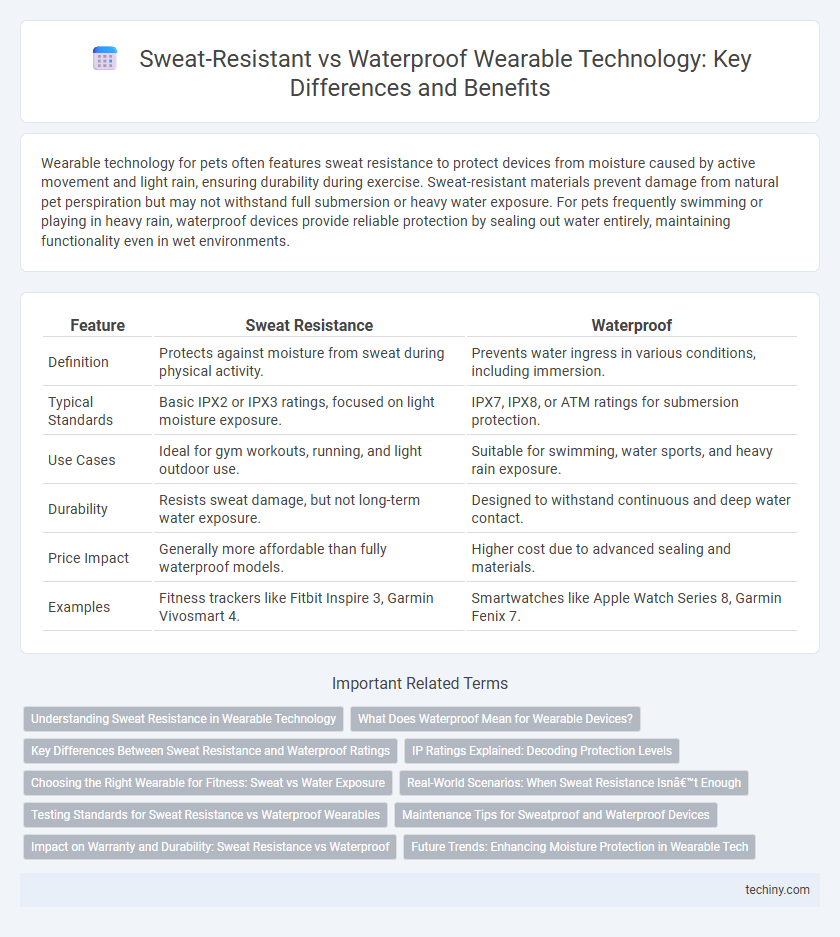Wearable technology for pets often features sweat resistance to protect devices from moisture caused by active movement and light rain, ensuring durability during exercise. Sweat-resistant materials prevent damage from natural pet perspiration but may not withstand full submersion or heavy water exposure. For pets frequently swimming or playing in heavy rain, waterproof devices provide reliable protection by sealing out water entirely, maintaining functionality even in wet environments.
Table of Comparison
| Feature | Sweat Resistance | Waterproof |
|---|---|---|
| Definition | Protects against moisture from sweat during physical activity. | Prevents water ingress in various conditions, including immersion. |
| Typical Standards | Basic IPX2 or IPX3 ratings, focused on light moisture exposure. | IPX7, IPX8, or ATM ratings for submersion protection. |
| Use Cases | Ideal for gym workouts, running, and light outdoor use. | Suitable for swimming, water sports, and heavy rain exposure. |
| Durability | Resists sweat damage, but not long-term water exposure. | Designed to withstand continuous and deep water contact. |
| Price Impact | Generally more affordable than fully waterproof models. | Higher cost due to advanced sealing and materials. |
| Examples | Fitness trackers like Fitbit Inspire 3, Garmin Vivosmart 4. | Smartwatches like Apple Watch Series 8, Garmin Fenix 7. |
Understanding Sweat Resistance in Wearable Technology
Sweat resistance in wearable technology refers to the device's ability to withstand moisture from perspiration without damage or malfunction, crucial for fitness trackers and smartwatches used during intense workouts. Unlike waterproof devices designed to endure full submersion in water, sweat-resistant wearables provide adequate protection against sweat penetration while maintaining breathability and comfort. Understanding sweat resistance ratings, such as IPX4 or higher, helps consumers select wearables that balance durability and usability during exercise.
What Does Waterproof Mean for Wearable Devices?
Waterproof wearable devices are engineered to prevent water ingress under specific conditions, typically measured by an IP rating such as IP68, which indicates protection against continuous immersion in water beyond 1 meter depth. Unlike sweat-resistant devices that only repel moisture from perspiration, waterproof wearables can withstand activities like swimming and showering without damage. Understanding the waterproof rating helps consumers select devices appropriate for aquatic environments and ensures durability during extended exposure to water.
Key Differences Between Sweat Resistance and Waterproof Ratings
Sweat resistance in wearable technology typically means the device can handle moisture from perspiration without damage, often rated IPX4 or similar, allowing limited water exposure. Waterproof ratings, such as IPX7 or IP68, indicate the device can withstand submersion in water for a specified depth and duration, providing full protection against water ingress. Understanding these ratings helps users select wearables suited for activities like intense workouts or swimming, ensuring durability and functionality.
IP Ratings Explained: Decoding Protection Levels
IP ratings classify wearable technology's protection against solids and liquids, with the first digit indicating dust resistance and the second indicating water resistance. Sweat resistance typically corresponds to lower IPX ratings like IPX4, meaning protection against splashes, while waterproof devices achieve higher ratings such as IPX7 or IPX8, capable of withstanding immersion in water. Understanding IP ratings allows consumers to select wearables that meet their activity needs, ensuring durability whether exposed to sweat or submerged in water.
Choosing the Right Wearable for Fitness: Sweat vs Water Exposure
When selecting wearable technology for fitness, understanding the difference between sweat resistance and waterproof capabilities is crucial for optimal performance. Sweat-resistant devices can handle moisture from intense workouts without damage, but waterproof wearables provide higher protection against submersion in water, making them ideal for swimming and water sports. Prioritizing features like IP ratings (e.g., IP67 vs IP68) ensures the device matches your specific fitness activities and exposure to sweat or water.
Real-World Scenarios: When Sweat Resistance Isn’t Enough
Sweat resistance in wearable technology protects devices from moisture generated during exercise but falls short in scenarios involving heavy rain, swimming, or accidental submersion where full waterproofing is essential. Devices with an IP68 rating or higher endure prolonged water exposure, making them ideal for triathletes and outdoor adventurers. Real-world use cases emphasize selecting a waterproof wearable to prevent damage during activities like open-water swimming or intense rainstorms, where sweat resistance alone cannot safeguard performance or longevity.
Testing Standards for Sweat Resistance vs Waterproof Wearables
Sweat resistance in wearable technology is often tested according to the IPX4 standard, which ensures protection against splashing water and sweat exposure during exercise. Waterproof wearables undergo more rigorous testing, typically meeting IPX7 or IPX8 ratings that certify submersion in water up to specific depths and durations. These standardized tests provide clear benchmarks for durability and usability in varying moisture conditions.
Maintenance Tips for Sweatproof and Waterproof Devices
Sweat-resistant wearable devices require regular cleaning with a soft, damp cloth to prevent sweat residue buildup that can cause skin irritation and device malfunction. Waterproof wearables demand thorough drying after exposure to water to avoid moisture trapped in seams or ports, which can lead to corrosion or electrical issues. Storing devices in cool, dry places and checking manufacturer guidelines for water resistance ratings enhances longevity and maintains optimal performance.
Impact on Warranty and Durability: Sweat Resistance vs Waterproof
Sweat-resistant wearable technology offers basic protection against moisture, which may not fully prevent damage from prolonged exposure or submersion, often leading to limited warranty coverage. Waterproof devices provide enhanced durability by withstanding immersion in water, significantly reducing the risk of malfunction and typically featuring more comprehensive warranty terms. Understanding the distinctions in moisture protection helps consumers select wearables that align with their activity levels and desired device longevity.
Future Trends: Enhancing Moisture Protection in Wearable Tech
Future trends in wearable technology emphasize advanced moisture protection through innovative materials and nanocoatings, significantly improving sweat resistance and waterproof capabilities. Emerging designs incorporate hydrophobic fabrics and sealed interfaces to protect sensitive components without compromising comfort or functionality. These enhancements enable wearables to withstand rigorous activities and diverse environments, broadening their usage in fitness, healthcare, and outdoor applications.
Sweat Resistance vs Waterproof Infographic

 techiny.com
techiny.com